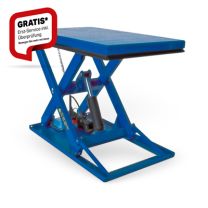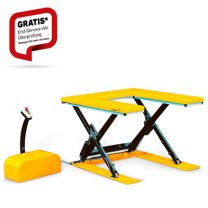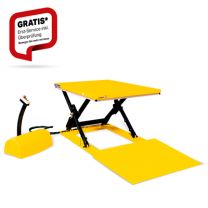Lift Tables

High quality lifting tables for every application
Countless different designs and surfaces. Special paintwork according to RAL, galvanized versions and stainless steel lifting tables (1.4301) in protection class IP 65.
Gesa. Your Partner for the perfect lifting table.

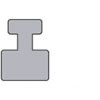 1000-4000 kg
1000-4000 kg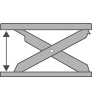 770-1050 mm
770-1050 mm- 500-1000 kg500-1600 mm
- 2000 kg900-1600 mm
- 3000 kg900-2000 mm
- 4000 kg1300-2000 mm
- 500-1000 kg800 mm
- 1000-2000 kg1420-1475 mm
Lifting and lowering - very easy - with scissor lift tables by Gesa Transporttechnik
In everyday work we often face challenges and it is a constant change of ups and downs in the warehouse or during assembly work.
The right work material can make your daily work a lot easier. With the lifting tables from Gesa Transporttechnik, work can be carried out at an ergonomic height and heavy objects can be lifted easily and conveniently. Depending on the model, the height of our lifting tables can be infinitely adjusted with a hydraulic or electro-hydraulic drive. Every employee can - regardless of his height - work in an ergonomically relaxed position by adapting the working height to his specific needs.
Overview of lifting functions:
Spindle drive:
The load platform is operated manually via a spindle drive - the lifting height is thus adjusted manually. Lifting devices with a spindle drive are particularly low-maintenance because they do not require an oil change. Even if you stand still for a long time, there is no loss of altitude - but a lot of effort is required to operate it.
Hand-hydraulic drive:
A hydraulic unit filled with oil starts the lifting and lowering movement. The hydraulic cylinders are actuated manually - the load can be easily raised with the foot pump and lowered continuously with the hand lever. A little effort is required.
Discover our models here: Lift table trolley
Electro-hydraulic drive:
The hydraulic lift is activated here by an electronic control. A slow and sensitive lifting and lowering of the load is hereby possible. Minimal effort is required to operate the lifting device. The electro-hydraulic drive is ideal for work with a lot of lifting operations, but these devices also require more maintenance: changing the hydraulic oil, charging the batteries, etc.
Function of a hydraulic lifting table short and compact
Stroke:
The actual lifting movement starts when the electric motor is switched on, which drives the gear pump. This pump transports the hydraulic oil from the tank and into the hydraulic circuit of the lift table, more precisely to the hydraulic cylinders. The inflowing oil ensures that the piston rods extend out of the cylinder tube.
Since the ends of the cylinder are connected to the inner scissors and the outer scissors, the cylinder extends the scissors and raises the platform.
Standstill:
If the desired stroke position is reached, the check valve ensures that that the hydraulic oil remains constant in the cylinder and the lifting table remains in the required position. In addition, the lowering valve also has a check valve so that the oil stays in the cylinders.
descending:
In principle, no drive is required for the lowering movement. The platform's own weight is sufficient to allow the cylinder to close again. To do this, the lowering valve is opened and the hydraulic oil can flow out of the cylinders into the tank again. By reducing the oil, the cylinders move together again and the platform lowers. For an appropriate lowering movement or lowering speed, a lowering brake valve is also installed in the hydraulic line, which regulates the maximum flow rate. The lowering speed remains moderate and does not become too great.
Different types of lift tables:
Lift table trolley
With the Lift table trolley as a mobile work table or workbench, employees can use it without much effort Adjust the workplace to the ideal working height. Also ideal for repair work in the company. Our lifting table trolleys can also be used optimally as a transport aid for tools and spare parts. The height is continuously adjustable by means of eclectic hydraulics or pump hydraulics. This allows you to work in a relaxed position, regardless of the size of the employee. A further distinction is made between compact lift tables and flat lift tables. The main difference is in the overall height - since the compact lifting table is larger.
Scissor lift tables
Our Scissor lift tables are robust and versatile lifting devices that are available in different designs and models exist. With the hydraulic lifting function, you can transport heavy loads to the desired height. Raising is stepless and lowering is effortless and gentle.
Easy loading and unloading with the lifting tables
Our scissor lifting tables are often used in materials and merchandise management as a lifting aid, as part of a Conveyor line in production or in various service companies.
Flexible work surface
Repairs or craft work with heavy materials are carried out safely on the platform of the lifting table. Our lifting tables are very popular as a durable, safe and robust work surface. They are an essential part of any company equipment. The lifting function is used to set the ideal working height - ergonomic working is possible at the "push of a button".
Flat lift tables
Our Flat lifting tables are used where heavy loads have to be lifted and differences in height have to be bridged, especially when a low loading height is required - for example in logistics companies, industrial halls or production companies. Our flat lifting tables are available with two types of platforms:
Closed platform
Here, palletized or non-palletized heavy goods can be lifted or lowered to the desired height. Due to its low overall height, the flat lifting table can be lowered to 85 mm and loaded or unloaded using a ramp using a pallet truck.
U or E platform
Forklifts or pallet trucks can enter here through the recess in the platform and deposit or pick up goods.
Loading lift tables
Our Loading lift tables are used especially in the logistics sector. They are the same when loading and unloading trucks. the height difference between the fixed loading ramp and the driveway. A typical feature of this lift table is the segmented loading flap that bridges the gap to the vehicle. With the right accessories, the loading lift table can be adapted to many different applications at the customer's request. For example, if the lifting table is to be run over with a vehicle when it is lowered, we provide a reinforced platform and additional support bolts for ideal force transmission in the pit to withstand the loads. The Gesa team will be happy to advise you on this!
Double scissor lift tables and multiple scissor lift tables
Double scissor lift tables and Multiple scissor lift tables offer access to great heights. They are used, for example, as a work platform, assembly lift or device for palletizing. Our double and multiple scissor lift tables are available in different designs and models. For standard products, the load capacity ranges from 200 kg to 4 tons and a lifting height of max. 4300 mm. Of course, there are various accessories for many areas of application such as railings, barriers, drive-over ramps, limit switches and various operating devices.
Special lifting tables
Special lift tables are lifting devices with special properties. The spring lifting table, for example, automatically keeps loads at the right height. For example, picking work can be carried out at an ergonomically correct height without bending or stretching. The goods can be turned into the right position thanks to the rotating surface integrated in the spring lifting table.
Actual load capacity of a scissor lift table
The European standard EN 1570-1 describes the safety requirements for industrial lifting tables. It also specifically regulates what a scissor lift should carry at least.
The EN 1570-1 standard specifies three for this Defaults:
1. With a full-surface load, the scissor lift must be exactly Have 100% of the specified load capacity.

2. If only half the platform length is loaded, the scissor lift table must still be able to carry 50% of the specified payload.

3. Should the lifting table loaded on half the broad side of the platform, it only has to carry a third of the specified payload. (With a load capacity of 1000 kg, that would be 330 kg that the lifting table lifts on half the broad side of the platform)
Explanation of payload with unequal load distribution :
The reason is the interaction of power and leverage. Depending on where the load is on the platform, it will stress the scissor cheeks of the lift.
Here is an example:
The burden lies between the hard - and floating bearing:
Here the load is exactly in the middle between the fixed and floating bearing of the lifting table. It is carried equally on both sides.
The load is on the edge of the platform :
Because the load lies unevenly on the platform, it also becomes not evenly supported by the fixed and floating bearing side. The floating bearing side has to absorb significantly more weight, while the fixed bearing side hardly has to lift any load. In this case, the floating bearing side is subjected to twice as much stress.
This example clearly illustrates why the load specification is not available for all load cases can apply. With this knowledge of scissor lift safety requirements, you are now ready to choose the ideal lift table for your operation.
So imagine buying a pair of scissors -Lift table the following question: If you would like to use the device to lift 1000 kg with an unequal load distribution, consider how and where the majority of the load is on the platform and select a Lift table with 2000 kg or a lift with max. 3000 kg load capacity.
stroke height:
To determine how high a lifting table can lift loads, you first have to deal with the construction of the lifting table. The stroke depends on the platform length. The scissors of the lifting table can only be smaller than the platform length. Likewise, the angle of the scissors must not be greater than 45°. This means that for a scissor length, the useful stroke must be divided by sin 45°.
An example:
You need a lifting table from Possess 2 meter stroke. The necessary scissor length can be easily calculated with the formula:
Scissor length = 2000 x sin 45° = 2000 x 0.707 = 2830
The scissor length for a stroke of 2 meters must be approx. 2830 mm long .
Since the scissor length is smaller than the platform, there is an allowance for lifting tables. This is approx. 150 mm for standard devices. This is usually where the foot guard and our limit switches are located. Now, to calculate the platform length for a lift table with 2830mm long scissors, simply add 150mm to the scissor length.
Platform length = 2830 + 150 = 2980
For a lift of 2 meters, a lift table with a platform length of at least 2980 mm required.
Advantages our Lift tables short and compact:
• High quality - robust multiplex panel, robust hydraulics, stable scissors, perfect workmanship;
• Robust and stable – base frame with powder-coated frame
• Fast and efficient - easy and precise lowering and lifting by electric hydraulics, battery or foot pedal
• Mobile and smooth-running - The smooth-running chassis allows for easy transport
• Flexible and adaptable - the extensive range of accessories allows for an expansion specifically tailored to your needs
• Ergon omical – back-friendly, work upright at a reasonable height
You are guaranteed to find the right lift table
When choosing the ideal lift table, start by asking yourself a few simple questions – um to shorten the search:
How much carrying capacity is required? How is the lifting table usually loaded in everyday work and is the lifting capacity still suitable for this?
What platform size (length and width) is ideal for you ? Are the dimensions of a regular standard lifting table or should it be a Tandem scissor lift table be?
Which platform type is best for your use case? Do you need an enclosed platform or is a U-shape or E-platform lift table better suited to your daily work?
Do you only want to lift materials with the device or also transport them? Ask yourself whether you need a stationary lifting table or a lighter one, mobile lifting table with which you can work at different locations in the company?
Do you want to use the lifting table to lift pallets or just individual objects, or maybe both? Should the lifting table be part of a conveyor line, should it lift and convey goods? Our employees in the area of conveyor technology will be happy to advise you on this by phone +43 463 34114-0 or send us an Request form.
How high should the lifting table be able to lift? Our standard lifting platforms have a maximum lifting height of 1600 mm or do you want to go even higher? You may then need a elevating work platform?
Should the lifting table also be able to tilt? Would a hub or Elevator the right one for your work area?
With the shopping options am At the top of our category page you can filter out all lifting tables according to your criteria with a few mouse clicks. – Or ask us, we will be happy to help you choose the right lifting table for your area of application.
You might also be interested in:
 |
Lifting devices and liftersIndustrial hoists and mini-lifts – light and versatile can be used. Our lifting solutions are real all-rounders. They are compact and versatile configurable with different chassis, hoists and many other extras. When Select it always depends on how much, what, where and how high you have to lift. |

















